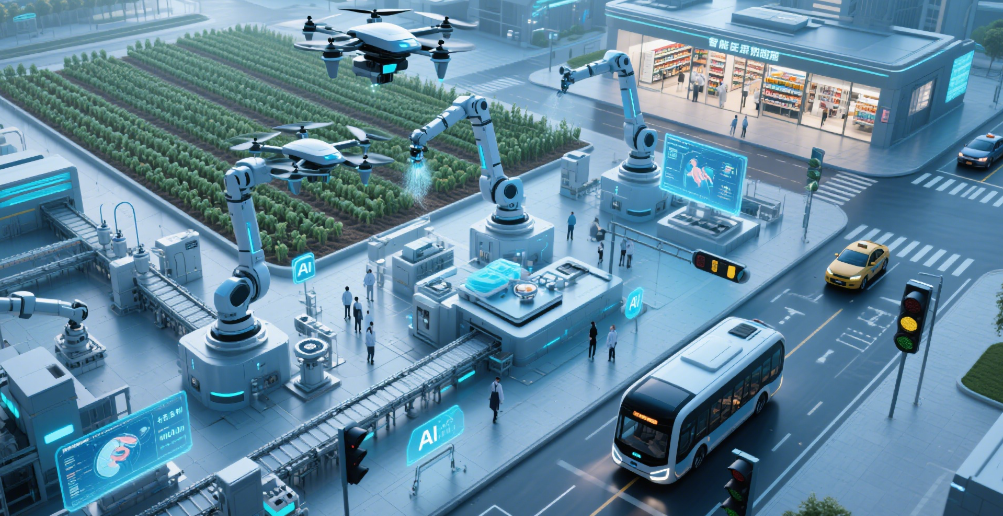A Review of the Development and Applications of AI Large Models
阳光 2025-06-17
The rapid advancement of AI large models has significantly impacted various fields, including natural language processing, computer vision, multimodal applications, and medical imaging. This paper provides a comprehensive review of the development and applications of AI large models in these domains. By analyzing recent research, this paper highlights the technological breakthroughs enabled by AI large models and discusses the challenges and future directions.
A Review of the Development and Applications of AI Large Models
Abstract
The rapid advancement of AI large models has significantly impacted various fields, including natural language processing, computer vision, multimodal applications, and medical imaging. This paper provides a comprehensive review of the development and applications of AI large models in these domains. By analyzing recent research, this paper highlights the technological breakthroughs enabled by AI large models and discusses the challenges and future directions.
1. Introduction
AI large models, characterized by their vast number of parameters and complex architectures, have become a driving force in the field of artificial intelligence. These models leverage large-scale data and advanced computational techniques to achieve remarkable performance in various tasks. This paper aims to provide an overview of the development and applications of AI large models in natural language processing, computer vision, multimodal applications, and medical imaging.
2. Applications in Natural Language Processing
Natural language processing (NLP) has seen significant advancements with the advent of AI large models. These models have demonstrated exceptional capabilities in understanding and generating human-like text.
2.1 Transformer Language Models
Transformer-based models have revolutionized NLP tasks. Large language models (LLMs) such as GPT have shown the ability to perform a wide range of language tasks, including text generation, translation, summarization, sentiment analysis, and question answering. These models are trained on massive datasets and leverage advanced attention mechanisms to capture intricate language patterns.
2.2 Notable Models
- GPT Series: Developed by OpenAI, the GPT series has evolved from GPT-1 to GPT-4, with each iteration significantly increasing in parameter size and capabilities. GPT-4 introduced multimodal capabilities, allowing it to understand images in addition to text.
- LLaMA Series: Introduced by Meta AI, the LLaMA series includes models with varying parameter sizes, demonstrating strong performance across multiple NLP tasks.
3. Applications in Computer Vision
Computer vision has also benefited from the development of AI large models, particularly in tasks such as image classification, segmentation, and generation.
3.1 Vision Transformer (ViT)
ViT has shown competitive performance compared to traditional convolutional neural networks (CNNs) by leveraging the Transformer architecture for image processing. This model divides images into patches and processes them similarly to tokens in text, capturing spatial and contextual information effectively.
3.2 MAE and VideoMAE
MAE, introduced by a team led by He Kaiming, applies self-supervised learning to ViT, achieving impressive results with significantly less training data. VideoMAE extends this concept to video data, demonstrating efficient pre-training for video analysis tasks.
4. Applications in Multimodal Applications
Multimodal AI large models integrate multiple types of data, such as text and images, to perform tasks that require understanding and generating content across modalities.
4.1 CogVLM
Developed by Tsinghua University and Zhiyuan AI, CogVLM integrates visual and language features, achieving top performance in multimodal benchmarks. This model demonstrates the potential of large models in tasks that require both visual and textual understanding.
4.2 LLaVA
LLaVA is a multimodal large language model that connects visual encoders with language models to perform generic visual and language understanding tasks. This model showcases the ability of large models to handle complex multimodal interactions.
5. Applications in Medical Imaging
Medical imaging has seen significant advancements with the application of AI large models, particularly in tasks such as diagnosis, segmentation, and image generation.
5.1 CheXzero and ChatCAD
CheXzero, a zero-shot chest X-ray classifier, has demonstrated radiologist-level performance in classifying multiple pathologies. ChatCAD integrates multiple diagnostic networks with ChatGPT, offering a potential application of LLMs in computer-aided diagnosis (CAD) for medical images.
5.2 MedCLIP and PLIP
MedCLIP is a contrastive learning framework that demonstrates impressive zero-shot medical image classification accuracy, particularly in detecting Covid-19 infections. PLIP, built using image-text pairs from medical Twitter, enables both image-based and text-based pathology image retrieval.
5.3 3D Medical LVMs
Developing 3D medical large vision models (LVMs) is crucial for handling 3D medical imaging modalities such as CT and MRI. Med3D, a heterogeneous 3D framework, shows strong generalization capabilities in downstream tasks like lung segmentation and pulmonary nodule classification.
6. Challenges and Future Directions
Despite the significant progress, AI large models face several challenges. The training and deployment of these models require substantial computational resources. Additionally, the interpretability of these models is often limited, which is a critical concern in fields like healthcare. Future research should focus on optimizing model architectures, improving interpretability, and addressing data privacy and security concerns.
7. Conclusion
AI large models have demonstrated remarkable capabilities in various fields, including natural language processing, computer vision, multimodal applications, and medical imaging. These models have enabled technological breakthroughs and have the potential to transform multiple industries. However, addressing the current challenges will be crucial for the continued development and application of AI large models.
Over 10,000 users are consulting. Click to apply for a trial.
iso25745电梯节能证书,重庆电梯节能有限公司,电梯节能 采购,pfe电梯节能装置,电梯节能减排,电梯节能问题,电梯节能设计,手扶电梯节能模式,电梯节能模式,电梯节能制度,电梯节能标准,电梯节能器,电梯节能装置价格,电梯节能降耗的措施有哪些,电梯节能管理,电梯节能项目,电梯节能产品,电梯节能技术的应用,电梯节能行业,电梯节能设备厂家,电梯设备品牌,电梯运行管理节能措施,电梯节能技术应用,电梯节能技术分析,电梯节能技术服务供应商,电梯节能技术的作用,电梯智能双碳节能箱,山东电梯节能,广东电梯节能,辽宁电梯节能,河南电梯节能,江苏电梯节能,浙江电梯节能,湖南电梯节能,广西电梯节能,上海电梯节能,四川电梯节能,安徽电梯节能,北京电梯节能,湖北电梯节能,天津电梯节能,河北电梯节能,福建电梯节能,陕西电梯节能,山西电梯节能,广西电梯节能,江西电梯节能,新疆电梯节能,黑龙江电梯节能,贵州电梯节能,内蒙古电梯节能,甘肃电梯节能,吉林电梯节能,云南电梯节能,电梯节能措施有哪些,电梯节能等级,电梯节能改造,电梯节能的前提条件,电梯节能等级标准,电梯节能等级分类,电梯节能等级划分,电梯节能等级认证,电梯节能等级认证证书,电梯有效节能,节能型电梯,电梯节能改造方案,电梯节能改造公司,电梯节能改造技术,电梯节能改造效果,常见的电梯节能控制,电梯的节能措施,电梯的节能技术有哪些,电梯节能减排措施,电梯节能系统,电梯节能系统研究,电梯如何节能,电梯节能减排措施包括,电梯节能减排措施方案,电梯节能降耗管理办法,电梯如何节能减排,电梯节能技术的应用,电梯节能技术分析,电梯节能技术概述,电梯节能技术设计,电梯节能技术实际案列,电梯节能技术现状,国企电梯节能,物业电梯节能,政府电梯节能,电梯节能指标,电梯节能新方案,电梯节能产品,电梯节能新时代,电梯节能策略,电梯节能绿色出行,电梯节能新策略,电梯节能的意义,如何实现电梯节能,电梯节能挑战,电梯节能的工作原理,电梯节能的技术创新,电梯节能的优势分析,电梯节能与绿色环保,电梯节能的转变与挑战,电梯节能关键技术推广,如何实现电梯节能,电梯节能降低运行成本,电梯节能的环保效益,电梯节能降低碳排放,电梯节能环保,电梯节能省钱又环保,电梯节能攻略,云南电梯节能降耗方案,大理电梯节能设备改造,红河州电梯节能技术,玉溪市电梯节能技术,怒江州电梯运行管理节能措施,云南电梯节能技术,电梯节能技术的作用,电梯节能技术服务供应商,电梯运行管理节能措施,节能电梯及控制方式的技术要点,节能电梯怎么节能,电梯节能技术的应用领域,电梯节能设备包括哪些,电梯节能方案设计,电梯节能技术的发展前景,电梯节能降耗方案,电梯节能箱是什么,电梯节能箱的作用,电梯节能改造效果,电梯节能回馈装置,电梯节能回馈装置的优点,国企电梯节能方案,电梯有效节能,电梯有效可行的节能措施,电梯运行管理的节能措施,电梯节能控制措施,常见的电梯节能控制技术,电梯节能技术服务供应商,电梯的节能,电梯节能率,电梯节能管理,东芝电梯节能,商场电梯节能,事业单位电梯节能,政府机构电梯节能,机关单位电梯节能,电梯节能政策,电梯节能资讯,电梯节能新闻,电梯节能案例,电梯节能应用,电梯节能特性,节能环保电梯,电梯怎么节能,电梯节能灯,电梯节能牌,日立电梯节能,电梯节能化,电梯分区节能,轿厢电梯节能,永大电梯节能,节能家用电梯,电梯节能感应,电梯安全节能,电梯安全节能管理制度,变频节能电梯,电梯安全与节能,电梯节能补贴,节能电梯发展,超级电容节能电梯,节能电梯专利,电梯节能服务,电梯节能解决方案,电梯节能装备,别墅电梯节能,别墅节能电梯厂商,电梯节能管理制度,电梯待机节能,贝壳电梯节能,柘城节能电梯,电梯节能设施,电梯节能方法,电梯节能工具,电梯系统节能,洛阳节能电梯,电梯节能运行,屹立节能电梯,林州节能电梯,电梯变频节能,舞阳节能电梯,电梯节能论文,战略电梯节能,电梯节能专利,电梯节能厂商,酒店电梯节能设计,公司节能电梯价格,扶手电梯节能,节能电梯标志图












